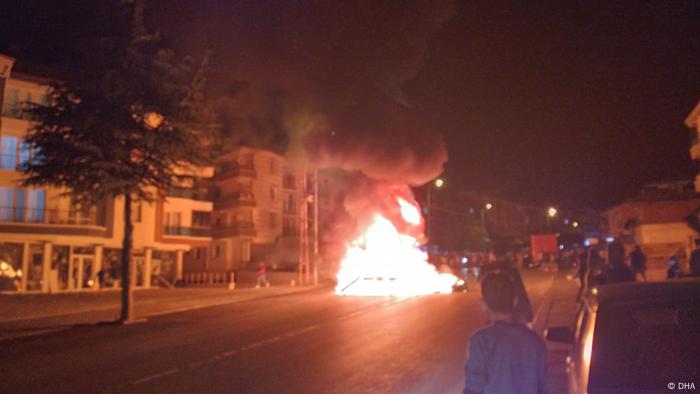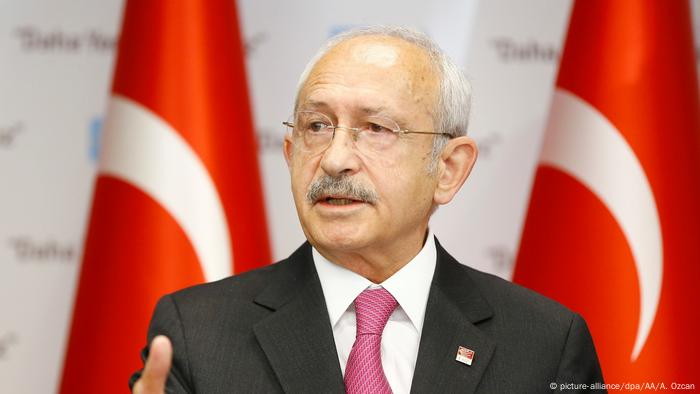There are approximately 4 million refugees in Turkey, and they are increasingly the objects of hostility — as the recent riots in Ankara have shown. Experts warn that the situation is likely to escalate in future

Young Turks making the far-right extremist 'wolf salute'
It all began on Tuesday evening when a street fight erupted between two groups of youths in Altindag, a district of the Turkish capital, Ankara. In the violent confrontation between some Syrian migrants and a group of Turkish locals, two Turks were stabbed. A few hours later, one of them, 18-year-old Emirhan Yalcin, died in hospital.
The event sparked a wave of xenophobia that resembled a pogrom. On Thursday night, hundreds of people poured onto the streets of Altindag. There, they vandalized and ransacked stores, homes and cars belonging to Syrian immigrants.
These ugly scenes could be followed live on Twitter: Numerous videos were posted on the social network showing the angry mob vandalizing Syrian property and shouting xenophobic slogans. Some of the rioters make the so-called "wolf salute" with their hands, the symbol of Turkey's right-wing extremist movement "UIlkucu," also known as the "Gray Wolves."
Meanwhile, xenophobic posts spread across social networks with hashtags like "We don't want any Syrians," "We don't want any Afghans," and "Turkey for the Turks."
Weak economy fueling discontent
For a long time, the Turkish government and population were tolerant of the millions of refugees and migrants in their country. In the past few years, though, the mood has changed. One of the main reasons for the increase in hostility toward migrants is that Turkey has been trapped in a prolonged economic and monetary crisis since the fall of 2018. This difficult situation has amplified existential fears in Turkish society and struggles over the distribution of wealth.
The xenophobic riots in Ankara came as no surprise to sociologist Ulas Sunata. She says they cannot be attributed solely to the bad economic situation. "Tensions between refugees and locals were never properly defused," she explains. "There have been a lot of mistakes in immigration policy. It was non-transparent and poorly communicated."
Sunata anticipates worse hostilities to come, warning that politicians who kept emphasizing that immigrants would soon be sent back have encouraged this response.

The mood has changed for the worse toward refugees in Turkey
Metin Corabatir, the president of the Research Center for Asylum and Immigration (IGAM), also holds politicians and their harsh rhetoric partly responsible. He, too, points out that many have repeatedly stressed their intention to send the refugees back soon. "They already have an eye on the 2023 elections," he explains.
Politicians promising deportations
He is referring primarily to the largest opposition party, the CHP, which recently ratcheted its anti-refugee rhetoric up a notch. CHP leader Kemal Kilicdaroglu declared that if his party came to power he would send all refugees back to their countries of origin.
There are an estimated 3.6 million Syrian refugees and migrants in Turkey, as well as refugees from Afghanistan, many of whom fled the radical Islamist Taliban militia. Hundreds of thousands are living in Turkey illegally, earn little and cannot access the health care system.

Opposition leader Kemal Kilicdaroglu wants refugees to leave Turkey
Are the Taliban causing new mass immigration?
Since the recent withdrawal of NATO troops from Afghanistan, the Taliban have managed to retake large parts of the country from the central government. Many Turks now fear that Turkey must expect a fresh wave of immigration. In addition, the Turkish government has been offering its services to the United States as a force to protect the civilian Afghan population. For example, President Erdogan plans to deploy Turkish soldiers to secure Kabul's Hamid Karzai Airport.
Washington, it seems, is happy to accept this offer. Last week, the US State Department announced a Refugee Action Plan for those Afghans who have cooperated with Washington and may therefore be persecuted by the Taliban. The program envisages temporary resettlement for them in Turkey.
This does beg the question of how much safer it will be for Afghan refugees there, given the intensity of the xenophobia that flared up in Ankara on Thursday.
This article has been translated from German.




 A Tigrayan refugee places a makeshift cross on the banks of the Setit River bordering Ethiopia ASHRAF SHAZLY AFP
A Tigrayan refugee places a makeshift cross on the banks of the Setit River bordering Ethiopia ASHRAF SHAZLY AFP





 Two centuries ago, the Postojna cave system, the longest in Europe, was unearthed by an amateur enthusiast Jure Makovec AFP
Two centuries ago, the Postojna cave system, the longest in Europe, was unearthed by an amateur enthusiast Jure Makovec AFP
 The medieval Predjama castle was built in a cave mouth to make access difficult and provide an escape route through a shaft in the rock face Jure Makovec AFP
The medieval Predjama castle was built in a cave mouth to make access difficult and provide an escape route through a shaft in the rock face Jure Makovec AFP





 Local officials say the dead bodies of hippos and fish have been found in contaminated waters in DR Congo, according to the environment minister ULISES RUIZ AFP
Local officials say the dead bodies of hippos and fish have been found in contaminated waters in DR Congo, according to the environment minister ULISES RUIZ AFP